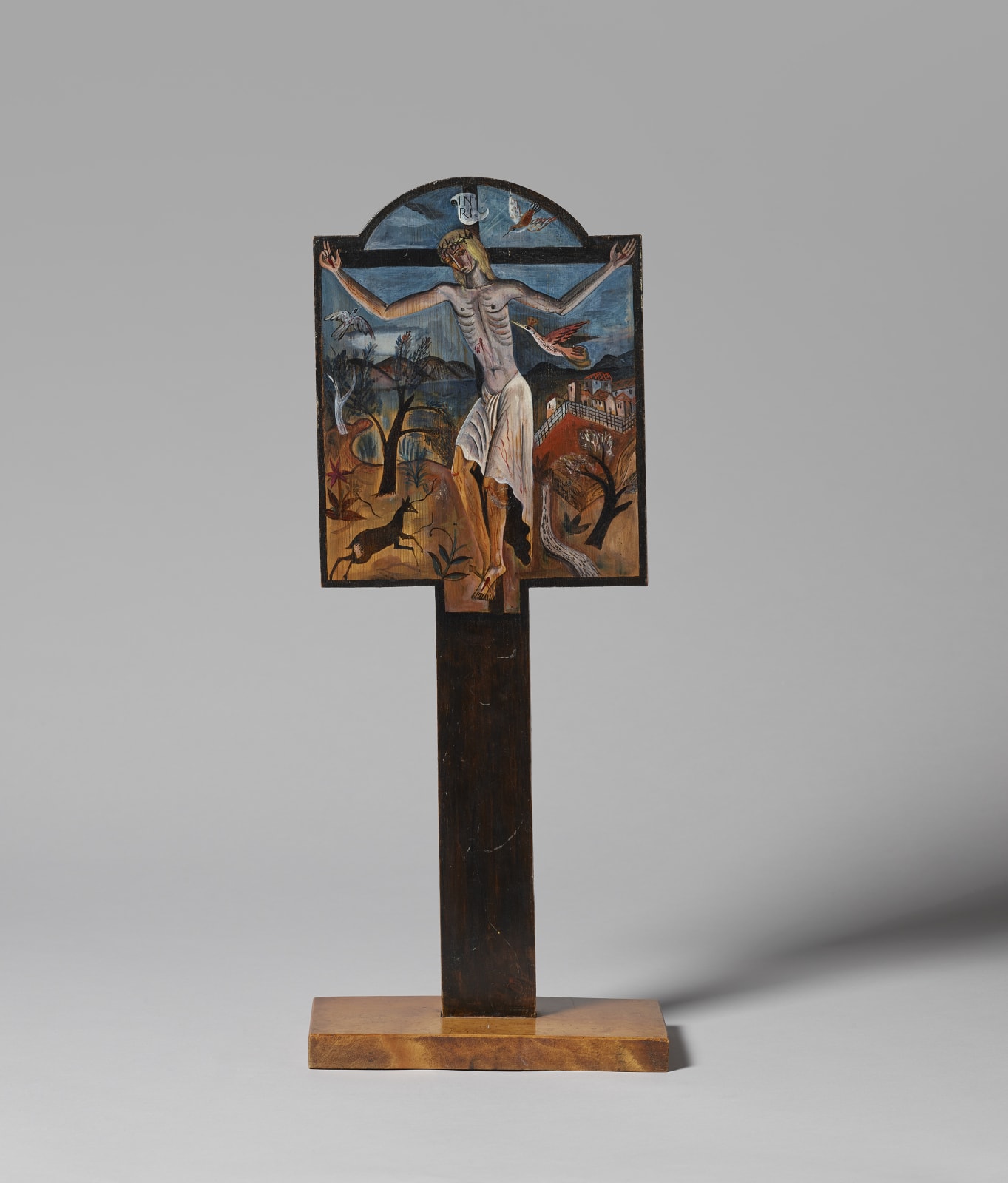David Jones 1895-1974
Crucifix for the Chapel at Pigott's, High Wycombe, 1925
oil on carved panel
height 22 1/2 inches
height 57.2 cm
height 57.2 cm
inscribed 'JESU/ESTO MIHI/JESUS' (on the reverse)
This unusual work was almost certainly made in 1925, when David Jones was staying regularly with Eric Gill at a former monastery at Capel-y-ffin, in the Black Mountains. Jones, whose...
This unusual work was almost certainly made in 1925, when David Jones was staying regularly with Eric Gill at a former monastery at Capel-y-ffin, in the Black Mountains. Jones, whose father was a Protestant lay preacher, converted to Catholicism in 1921. He first studied under Gill at his medieval-style Guild of St Joseph and St Dominic at Ditchling in 1922, learning carpentry and wood engraving, later joining Gill’s family in Wales at Christmas 1924, having become engaged to his daughter Petra, although their engagement was eventually called off.
At this point, Jones’ practice was heavily indebted to Gill’s hieratic style; however, between 1924 and 1927, we find a gradual assimilation of Gill’s teachings within his own, emerging style. This development was in part driven by Jones’ aesthetic response to his new surroundings. Although he had grown up in London, his father was from Holywell and he strongly identified with his welsh heritage and the dynamic nature of the landscape, ‘the strong hill-rhythms and the bright counter-rhythms of the afonydd dyfroedd, the water-brooks which makes so much of Wales a “plurabelle” ’. 1
On arriving at Capel-y-ffin Jones immediately set about painting a large crucifixion on the wall of the chapel. Both this mural and the Tate Gallery’s small gouache, Sanctus Christus de Capel-y-ffin, 1925, reveal the influence of Gill, Italian primitive art, and, perhaps, an awareness of Cézanne, but the figures have the stiffness of wood carvings. In fact, Jones made numerous small boxwood carvings during this time, so the present work might be considered a hybrid of these two forms.
In the Tate’s painting, the felled trees, dramatic rupture between the mountains and cold palette invoke Christ’s suffering. Here, the birds, deer and flowering plants denote spring or summer, and Jones offers a more human figure of Christ, looking directly out to the viewer. While the organisation of space is indebted to his training in engraving, where multiple elements must be fitted together, there is a liveliness to the imagery which anticipates Jones’ mature style.
In 1928, Gill left Capel-y-ffin to settle at Pigotts Farmhouse near High Wycombe. Walter Shewring’s book Making and Thinking cites the owner of this work as Mrs Eric Gill and the title as ‘Crucifix Painted for Pigotts Chapel’, suggesting this was a personal gift from Jones to Gill. Painted on the back is the Latin inscription ‘Jesu Esto Mihi Jesus’ meaning ‘Jesus be to me my Saviour’ a popular inscription in churches, which is recited as a short prayer.
1 David Jones, Epoch and Artist, Faber and Faber, London, 1973, p30
At this point, Jones’ practice was heavily indebted to Gill’s hieratic style; however, between 1924 and 1927, we find a gradual assimilation of Gill’s teachings within his own, emerging style. This development was in part driven by Jones’ aesthetic response to his new surroundings. Although he had grown up in London, his father was from Holywell and he strongly identified with his welsh heritage and the dynamic nature of the landscape, ‘the strong hill-rhythms and the bright counter-rhythms of the afonydd dyfroedd, the water-brooks which makes so much of Wales a “plurabelle” ’. 1
On arriving at Capel-y-ffin Jones immediately set about painting a large crucifixion on the wall of the chapel. Both this mural and the Tate Gallery’s small gouache, Sanctus Christus de Capel-y-ffin, 1925, reveal the influence of Gill, Italian primitive art, and, perhaps, an awareness of Cézanne, but the figures have the stiffness of wood carvings. In fact, Jones made numerous small boxwood carvings during this time, so the present work might be considered a hybrid of these two forms.
In the Tate’s painting, the felled trees, dramatic rupture between the mountains and cold palette invoke Christ’s suffering. Here, the birds, deer and flowering plants denote spring or summer, and Jones offers a more human figure of Christ, looking directly out to the viewer. While the organisation of space is indebted to his training in engraving, where multiple elements must be fitted together, there is a liveliness to the imagery which anticipates Jones’ mature style.
In 1928, Gill left Capel-y-ffin to settle at Pigotts Farmhouse near High Wycombe. Walter Shewring’s book Making and Thinking cites the owner of this work as Mrs Eric Gill and the title as ‘Crucifix Painted for Pigotts Chapel’, suggesting this was a personal gift from Jones to Gill. Painted on the back is the Latin inscription ‘Jesu Esto Mihi Jesus’ meaning ‘Jesus be to me my Saviour’ a popular inscription in churches, which is recited as a short prayer.
1 David Jones, Epoch and Artist, Faber and Faber, London, 1973, p30
Provenance
Mrs Eric GillJoanna Gill and René Hague
with Anthony d'Offay Gallery, London
Private Collection, acquired from the above in 1982
Thence by descent
Literature
Walter Shewring, Making & Thinking, Catholic Art Association, Buffalo, New York, 1958, illus b/w p88, pl.1, where cited as from the collection of Mrs Eric Gill1
of
2
